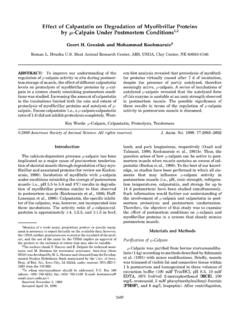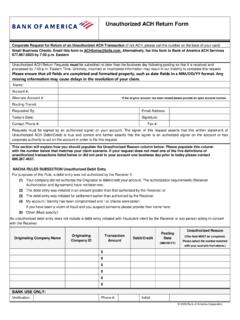Transcription of Dietary Fiber Intake of the U.S. Population
1 Highlights Food Surveys Research Group Dietary Data Brief No. DEPARTMENT OF AGRICULTURE Agricultural Research Service Beltsville Human Nutrition Research Center Food Surveys Research Group 12 The average daily Dietary Fiber Intake was 16 grams per day. The diets of females have a higher Fiber density compared to males. The top three WWEIA Food Categories that contribute to Fiber Intake are Vegetables, Fruits, and Breads, rolls, tortillas. September 2014 Fiber Intake of the Population What We Eat in america , NHANES 2009-2010 The mean Dietary Fiber Intake of all individuals 2 years and older, excluding breastfed children, was 16 grams per day. Intakes of males and females were 18 and 15 grams per day, respectively (data not shown). As Figure 1 shows, Intake of males 12 years and older was significantly greater than females. Blacks had significantly lower Dietary Fiber Intake (13 gm) compared to Whites (16 gm) and Hispanics (17gm) (data not shown).
2 What is the Fiber Intake of the Population ? Figure 1. Fiber Intake of Population , WWEIA, NHANES 2009-2010 18 12 14 16 18 20 18 15 11 14 13 15 16 15 0 5 10 15 20 25 All 2-5 6-11 12-19 20-39 40-59 60+ Age (years) Males Females Fiber (gm) * * * * * *Significantly different from females (p< ) SOURCE: What We Eat in america , NHANES 2009-2010, day 1, individuals 2+ years M. Katherine Hoy, EdD, RD and Joseph D. Goldman, MA + Dietary Fiber is the non-digestible form of carbohydrate found in plant foods, including fruits and vegetables, whole grain products, beans, nuts and seeds. It provides bulk in the diet, which helps promote healthy gastrointestinal function and contributes to a feeling of fullness after eating. A high Fiber diet may also assist in weight management, reduce risk of cardiovascular disease and Type 2 diabetes, and help improve blood sugar levels in people with diabetes (1).
3 Most individuals do not meet Institute of Medicine Adequate Intake recommendations (2, 3), and the 2010 Dietary Guidelines for Americans identified Dietary Fiber as a nutrient of concern (1). This report describes the Dietary Fiber Intake of the Population and the contribution of foods to Population Dietary Fiber Intake as reported in What We Eat in america , NHANES 2009-2010. FSRG Dietary Data Brief -- No. 12 September 2014 Fiber Intake is influenced by energy Intake . Figure 2. Fiber density (gm/1000 kcal) of Population , WWEIA, NHANES 2009-2010 -2 - 8 8 7 7 7 8 9 9 8 8 7 8 9 10 0 2 4 6 8 10 12 All 2-5 6-11 12-19 20-39 40-59 60+ Males Females * * Age (years) *Significantly different from males (p< ) Within gender, Intake of males and females 60+ years significantly higher than other age groups combined, p< SOURCE: What We Eat in america , NHANES 2009-2010, day 1, individuals 2+ years Fiber density (gm/1000 kcal) The higher Dietary Fiber Intake of males may be explained, in part, by their higher energy intakes.
4 When Fiber Intake is adjusted by energy Intake , adult females had a higher Dietary Fiber Intake than their male counterparts, as shown in Figure 2. Within gender, Dietary Fiber density (gm/1000 kcal) of the diets of those over 60 years was significantly higher than younger age categories combined. These differences may be related to food choice. * * FSRG Dietary Data Brief -- No. 12 -- September 2014 -3 - How can Dietary Fiber density be increased? The Dietary Fiber density of the diet can be increased by including fruits, vegetables and whole grains that are Fiber -rich (3 grams or more Fiber per labeled serving (3)). In Table 1, the Dietary Fiber content of different forms of several representative food items are compared. The table illustrates how Dietary Fiber Intake can be increased by including high Fiber items such as chili con carne with beans, or by choosing less processed forms such as brown rice instead of white rice.
5 More information about other specific foods can be found using the What s In the Foods You Eat Search Tool ( ). Foods Dietary Fiber (gm) per 100 gm Common measure Dietary Fiber (gm) per common measure Apple, raw, with skin 2 1 medium 4 Apple juice 0 cup 0 Bran flakes 18 cup 4 Corn flakes 3 cup Bread, 100% whole wheat 7 1 regular slice 2 Bread, white 3 1 regular slice 1 Brown rice, cooked 2 1 cup 4 White rice, cooked 1 cup 1 Corn tortilla, 6-inch 6 1 2 Flour tortilla, white, 6-inch 2 1 1 Chili con carne with beans 3 1 cup 7 Chili con carne, without beans 1 1 cup 3 Table 1. Comparison of the Fiber content of different forms of selected foods Based on the Food and Nutrient Database for Dietary Studies (FNDDS) used to process and analyze What We Eat in america , NHANES Dietary Intake data (4). Underlying food composition data are from the USDA National Nutrient Database for Standard Reference 24 (5).
6 FSRG Dietary Data Brief -- No. 12 -- September 2014 Vegetables and Fruits were the highest contributors to Dietary Fiber Intake , as shown in Table 2. Together, they accounted for just over one-quarter (28%) of Population Intake . White potatoes alone accounted for about one-third of the Vegetable contribution. Of the Fruits, apples and bananas were the highest contributors. Breads, rolls and tortillas provided 12% of Dietary Fiber Intake , of which half was from yeast breads. Cereals contributed 8%, primarily from ready-to-eat cereals (6%). Dietary Fiber Intake from plant-based protein foods such as beans, legumes and nuts was 8%. Grain-based mixed dishes such as pasta dishes and macaroni and cheese, and pizza were the primary contributors to Dietary Fiber Intake from all mixed dishes. Sweet bakery products, candy and other desserts provided 7% , with over half from bakery items such as cakes, pies, cookies and doughnuts.
7 Savory snacks and crackers contributed 6%, primarily from popcorn and tortilla chips. What foods contribute to Fiber Intake of the Population ? Table 2. Contribution of What We Eat In america Food Categories to Fiber Intake of Population , WWEIA, NHANES, 2009-2010. -4 - FOOD CATEGORIES Individuals Reporting (%) Contribution to Dietary Fiber (%) Vegetables: fresh, frozen, and canned vegetables, including potatoes 67 16 Fruits: fresh, frozen and canned fruit 48 12 Breads, rolls, tortillas: yeast breads and rolls, flour and corn tortillas, bagels, English muffins 66 12 Grain-based mixed dishes: pasta dishes, macaroni and cheese, burritos, tacos, tamales, fried rice, 33 9 Cereals: cooked and ready to eat cereals 33 8 Plant-based protein foods: beans, peas, legumes, nuts and seeds, processed soy products 28 8 Sweet bakery products, candy, other desserts: cakes, pies, cookies, snack/meal bars, ice cream 65 7 Savory snacks and crackers: potato chips, tortilla and corn chips, popcorn 46 6 Pizza.
8 Fast food/restaurant and frozen pizza 14 4 Percentage of individuals reporting the foods in the category at least once on the reporting day. Food categories not listed including soups, milk and dairy, burgers, and meat, poultry, seafood mixed dishes, contributed 3% or less to Fiber Intake . SOURCE: What We Eat in america , NHANES 2009-2010, Day 1 Dietary Intake data, weighted. FSRG Dietary Data Brief -- No. 12-- September 2014 Adequate Intake : The recommended average daily Intake level based on observed or experimentally determined approximations or estimates of nutrient Intake by a group (or groups) of apparently healthy people that are assumed to be adequate used when an Estimated Average Requirement (EAR) cannot be determined. (6) Definitions Estimates in this report are based on one day of Dietary Intake data collected in What We Eat in america , the Dietary Intake interview component of the National Health and Nutrition Examination Survey (NHANES) in 2009-2010.
9 Data on Fiber consumption and contribution of foods to Dietary Fiber Intake are based on Day 1 Dietary Intake data of 9042 individuals age 2 years and older with complete and reliable intakes, excluding breastfed infants. Sample weights were applied in all analyses to produce nationally representative estimates. Data source 1. Department of Agriculture and Department of Health and Human Services. Dietary Guidelines for Americans, 2010. 7th Edition, Washington, DC: Government Printing Office, December, 2010 2. Department of Agriculture, Agricultural Research Service. " Dietary Fiber : Usual Intakes from Food and Water, 2003-2006, Compared to Adequate Intakes" Accessed October 28, 2013 3. Food and Drug Administration. Code of Federal Regulations, title 21,volume 2. Subpart D - Specific Requirement for Nutrient Content Claims Accessed September, 2013.
10 4. Ahuja JKA, Montville JB, Omolewa-Tomobi G, Heendeniya KY, Martin CL, Steinfeldt LC, Anand J, Adler ME, LaComb RP, and Moshfegh AJ. 2012. USDA Food and Nutrient Database for Dietary Studies, 5. Department of Agriculture, Agricultural Research Service. 2011. USDA National Nutrient Database for Standard Reference, Release 24. 6. National Research Council. Dietary Reference Intakes for Energy, Carbohydrate, Fiber , Fat, Fatty Acids, Cholesterol, Protein, and Amino Acids (Macronutrients) . Washington, DC: The National Academies Press, 2005. Department of Agriculture, Agricultural Research Service. 2013. What We Eat in america Food Categories 2009-2010. Available: . Accessed 10/29/13. References -5 - Fiber density: The amount of Fiber in a specified amount of a food or diet in order to make comparisons. Comparisons of the Fiber density of foods are usually on a per 100 gram basis, and comparisons of the Fiber density of the diet are usually on a per 1000 kcal basis.













